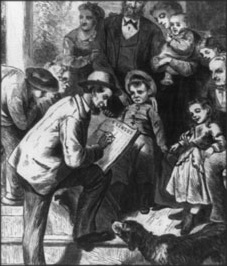The authority to amend the Constitution of the United States is derived from Article V of the Constitution. After Congress proposes an amendment, the Archivist of the United States, who heads the National Archives and Records Administration (NARA), is charged with responsibility for administering the ratification process under the provisions of 1 U.S.C. 106b.

The Constitution provides that an amendment may be proposed either by the Congress with a two-thirds majority vote in both the House of Representatives and the Senate or by a constitutional convention called for by two-thirds of the State legislatures. None of the 27 amendments to the Constitution have been proposed by constitutional convention. The Congress proposes an amendment in the form of a joint resolution. Since the President does not have a constitutional role in the amendment process, the joint resolution does not go to the White House for signature or approval.
The Archivist submits the proposed amendment to the States for their consideration by sending a letter of notification to each Governor along with the informational material prepared by the Office of the Federal Register (OFR). The Governors then formally submit the amendment to their State legislatures. In the past, some State legislatures have not waited to receive official notice before taking action on a proposed amendment. When a State ratifies a proposed amendment, it sends the Archivist an original or certified copy of the State action, which is immediately conveyed to the Director of the Federal Register
A proposed amendment becomes part of the Constitution as soon as it is ratified by three-fourths of the States (38 of 50 States). When the OFR verifies that it has received the required number of authenticated ratification documents, it drafts a formal proclamation for the Archivist to certify that the amendment is valid and has become part of the Constitution.
via The Constitutional
Amendment Process
Far more amendments have been proposed than have ever been passed by Congress or gone to the states for ratification.
Notable Failed Amendments
Prior to 1919 when the 18th Amendment was ratified, there was no time limit on the ratification process. However, in 1919, Congress instituted a time limit on the passage of a proposed addition to the Constitution.
Approximately 11,539 measures have been proposed to amend the Constitution from 1789 through January 2, 2013.
Some prominent proposals included:
19th century
- Blaine Amendment, proposed in 1875, would have banned public funds from going to religious purposes, in order to prevent Catholics from taking advantage of such funds. Though it failed to pass, many states adopted such provisions.
- Christian Amendment, proposed first in February 1863, would have added acknowledgment of the Christian God in the Preamble to the Constitution. Similar amendments were proposed in 1874, 1896 and 1910 with none passing. The last attempt in 1954 did not come to a vote.
- The Crittenden Compromise, a joint resolution that included six constitutional amendments that would protect slavery. Both the House of Representatives and the Senate rejected it in 1861 and Abraham Lincoln was elected on a platform that opposed the expansion of slavery. The South’s reaction to the rejection paved the way for the secession of the Confederate states and the American Civil War.








